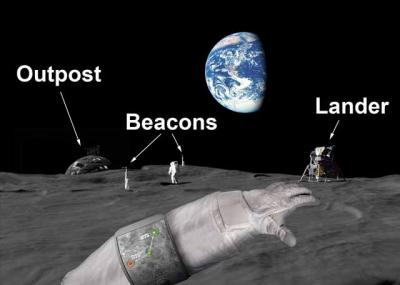
The Crazy Lune

 |
The Crazy Lune |
 |
|---|
      |
|
RFID Link Budget
The following are the specifications for the RF hardware used on the astronaut to RFID tag link: |
|
Tphy=93 K; Physical temperature on Moon's Surface NFP=1.8 dB; Noise Figure for the Power Splitter GP=-3 dBi; Gain of the Power Splitter NFLNA=0.8 dB; Noise Figure for the Low Noise Amplifier GLNA=19.8 dBi; Gain of the Low Noise Amplifier NFBPF=1.9 dB; Noise Figure for the Band Pass Filter GBPF=-2 dBi; Gain of the Band Pass Filter NFMIXER=4.5 dB; Noise Figure for the Mixer GMIXER=-5 dBi; Gain of Mixer NFPA=5 dB; Noise Figure of the Power Amplifier GPA=50 dBi; Gain of the Power Amplifier A physical temperature of 93 K is chosen, since the astronaut will be operating in the lunar night (Jiahui Yuan; Cressler, J.D.; Yan Cui; Guofu Niu; Finn, S.; Joseph, A., "On the profile design of SiGe HBTs for RF lunar applications down to 43 K," Bipolar/BiCMOS Circuits and Technology Meeting, 2008. BCTM 2008. IEEE, pp.25-28, 13-15 Oct. 2008). The effective system temperature is calculated according to the following expression: Finally, the received noise power can be determined from the signal bandwidth and the system temperature,
The following values were used for the physical parameters while making the calculations:
c=3*10^8 m/s; Speed of light k_B=1.3807*10^23 J/K; Boltzman’s Constant The Carrier to Noise Ratio(despread) for the Astronaut to the RFID tags link largely depends on the Chip Rate used which in turn depends on bit rate and the length of the chipping sequence. We assume a chip sequence of 20480 bits(Gold Codes). The average distance between the Astronaut and RFID Tag is assumed to be 10 meters. We chose a center frequency of 1.031 GHz and bandwidth for the link was calculated as M/Tbit. We picked a center frequency close to the lower bound to minimize the path loss.
The gain of Astronaut's antenna is 2 dBi and for RFID tag is 0 dBi. The efficiency of RFID tags is assumed to be 50 % , which accounts for the percentage of received power diverted to charge the capacitors embedded in the tags. We assumed a conservative path loss exponent of n=2.2 considering the fact that there are no high rise buildings on the Moon's surface and the terrain is relatively even. Figure 2. The above figure shows the change in Transmit Power of the Astronaut against the Maximum Distance between the Astronaut and the RFID tags (i.e. the maximum range of the Astronaut to RFID Tags link).
We had to balance the trade off of finding a considerable distance against reasonable transmit power. As can be observed from the figure above, the transmit power increases significantly with the increase in the maximum distance. We needed a large enough range to limit the number of tags the astronaut drops during his expedition. But at the same time, we needed to limit our transmit power to a feasible value as it accounts for major power consumption from the batteries. Hence, we decided on a maximum distance of 50 meters with corresponding RF transmit power of 63 Watts. As we are sending out just short pulses (see section distance measurement), the average power will be far less, less than a Watt (0.65W). Therefore and due to the fact that the astronaut has a very good shielding, the radiation will be no health issue for the astronaut.
|
Home | Project | Communication | Location | Power | Budget & Timeline Tuesday, December 8, 2009 © 2009 The Crazy Lune. All rights reserved. |